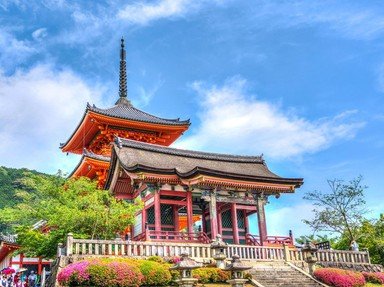Quiz Answer Key and Fun Facts
1. This massive Buddhist temple is located in an island country with the world's largest population of Muslims. Where would you find Borobudur Temple Compounds?
2. This structure is known as the Great Torii Gate and is located offshore of the island of Itsukushima. In which country will you find this holy place of Shintoism?
3. One of the best-preserved Roman temples in the world, the Temple of Bacchus is part of the Phoenician/Roman temple complex of Baalbek. In which western Asian country will you find the UNESCO World Heritage Site of the city and district of Baalbek?
4. Throwing you a bone on this one, which is appropriate since "The Far Side" cartoonist Gary Larson maintained that this structure was built to keep out a dog. This very long UNESCO World Heritage site is located in which country?
5. Terraced basins of calcium-rich thermal springs create the other-worldly site of Pamukkale. Along with Greco-Roman ruins from the ancient city of Hierapolis, UNESCO recognized the site for both its natural and man-made beauty. The joint site of Hierapolis-Pamukkale is located in the Asian region of which country that straddles two continents?
6. This massive edifice composed of red sandstone was built in the 1600s for Shah Jahan. In which country will you find the UNESCO World Heritage Site of the Red Fort Complex? There's a vexillological clue if you enlarge the photo.
7. One of the largest religious monuments in the world, this complex originally was built as a Hindu temple before being converted to Buddhist site. Which country has this World Heritage Site on its flag?
8. This picture displays the Farah Baksh terrace which is part of the Shalimar Gardens complex. Along with the nearby Lahore Fort, the Shalimar Gardens complex is a World Heritage Site in the Punjab region of which populous Asian country?
9. This unique attraction is a Buddha head entwined in tree roots and is located at Wat Mahathat, part of the Ayutthaya Historical Park. The city of Ayutthaya was at one time a secondary capital of the Siamese kingdom. In which southeastern Asian country will you find this World Heritage site?
10. Terracing is a common agricultural technique for creating arable land in mountainous regions, and rice terraces in particular are popular in Asia. The Rice Terraces of the Cordilleras is a World Heritage Site in which southeast Asian island nation?
Source: Author
PDAZ
This quiz was reviewed by FunTrivia editor
stedman before going online.
Any errors found in FunTrivia content are routinely corrected through our feedback system.
